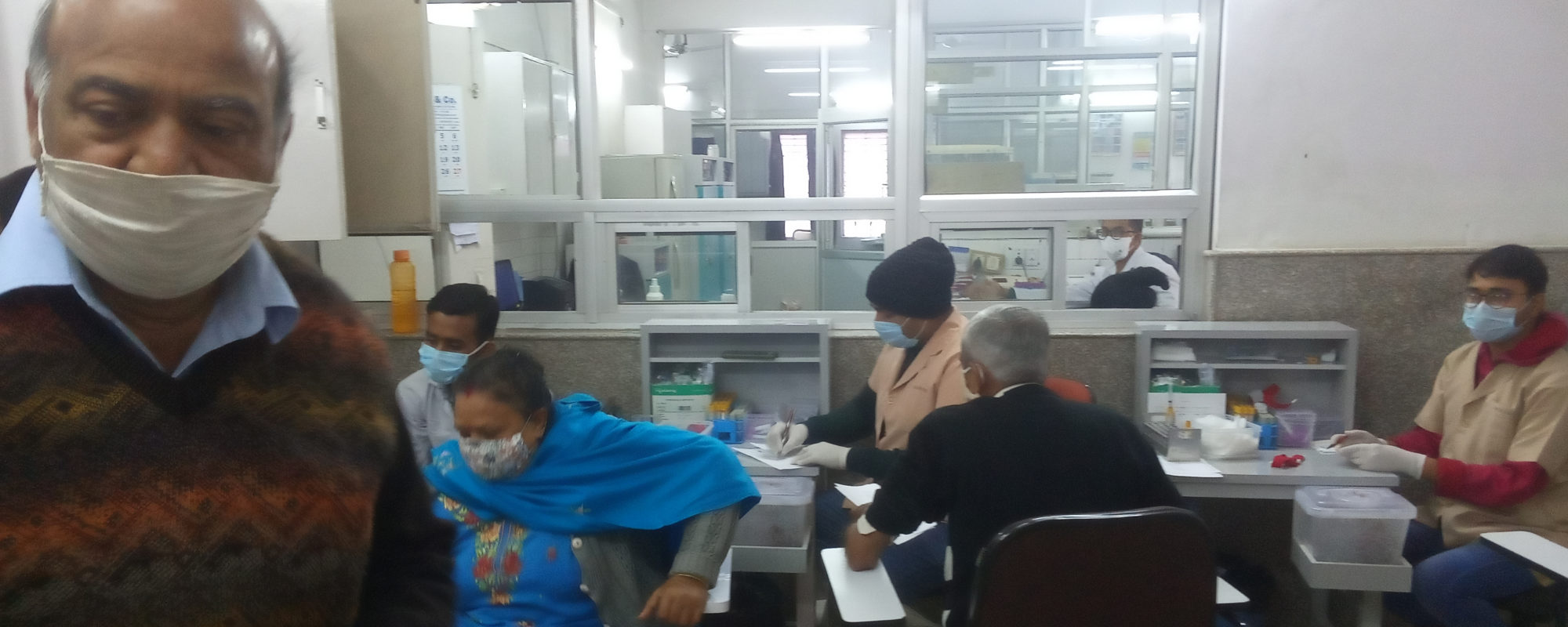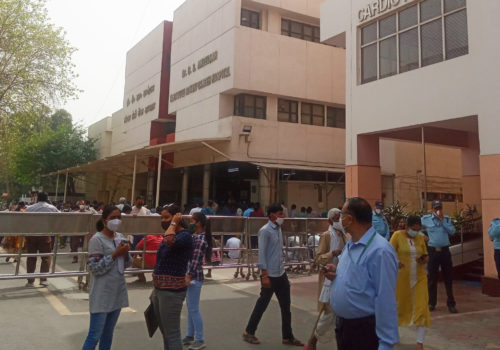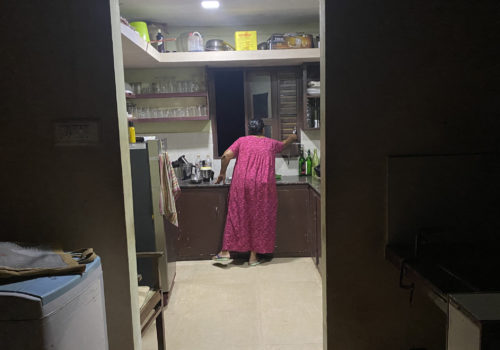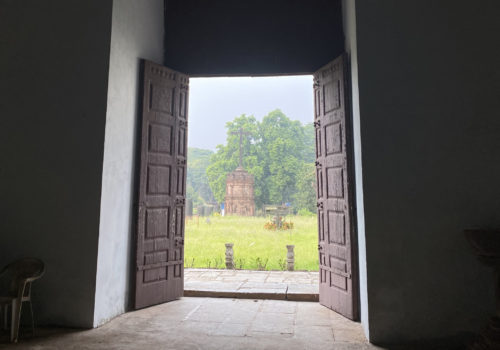DELHI — Human life is cheap in India. Few know that better than my mother, who has witnessed tragedy in her family from a young age. Cancer has spread like wildfire and organs have failed; kidneys have been readily donated among her parents and eight siblings. Three of her brothers died—one of them hesitant to buy medicine while on his deathbed in order to save money for the family he would leave behind. “Every small and big thing became a struggle,” she lamented on the phone from Sydney, where my family eventually moved two decades ago.
Last weekend, I witnessed the struggle firsthand. Her oldest sister was admitted to a private hospital in the northern city of Lucknow, where she scrambled to find oxygen. She had tested positive for the virus despite having received a first dose of Covid-19 vaccine. So many others have been stricken too: The authorities have reported at least 300,000 new cases and 4,000 deaths each day over the past week, although experts believe the real numbers to be much higher. The surge has shocked the country after daily cases fell as low as around 8,000 in February.
On Saturday, my 73-year-old aunt’s face appeared pale and washed-out in a WhatsApp family video chat. Her children, who live in the United States, watched their mother gasp for air on their screens—a dystopian reminder of how fragmented connection to loved ones has become.
From my apartment in New Delhi, which has been under lockdown for the past week, I spent hours on the phone with doctors and medical suppliers in a desperate bid to find medical oxygen. Help came piecemeal, never all at once: If a hospital had a bed available, there was no ventilator; if a ventilator was found, it was short of oxygen; if oxygen was found, it came in cans and not cylinders, which is what my aunt needed while connected to a Bilevel Positive Airway Pressure (BiPAP) machine. Her oxygen levels improved marginally one minute before plummeting the next. Doctors told my uncle that without securing oxygen, they would need to discharge her.
Thousands of similar accounts have flooded social media since the beginning of April, when cases began skyrocketing across the country. But no amount of tweets, Instagram posts or news stories about the pandemic could have prepared me for the feeling of helplessness that hit me after placing at least 50 calls to strangers in Lucknow. “There are no oxygen cylinders left in this city,” one hospital administrator told me. “We have lines of people waiting for ventilators,” another said. A medical supplier who charged an astounding $33 for a can of oxygen on the black market was equally frank: “We want to try and save as many lives as possible, but everything is costing so much.”
But for my family, every minute spent trying to save my aunt’s life was priceless.
Indian families operate like clans, writes the British novelist V.S. Naipaul. Each provides protection and identity, and sometimes has even “saved people from the void.” As my mother’s own clan grew with each generation, many members moved across India and around the world seeking better opportunities, making it difficult to keep track of who lives where at any given moment. Still, in the family group chat—named Sab Apne, which loosely translates from Hindi to “all our loved ones”—there is an update, joke or birthday greeting almost every day. When I moved back to India last year, the group no longer felt like a distant portal into all these lives; I could finally draw connections among aunts and uncles who were still here, as well as their children scattered far and wide. Now it was heartbreaking for all of us to see our oldest member fall victim to the virus
I woke up to more gutting news from my mother on Sunday morning: “Dr said her condition is very critical. Now no hope.” In a panic, I once again scoured Twitter and Instagram for phone numbers on crowdsourced lists of Covid resources that have steadily replaced national helplines. I wasn’t the only one working the phone lines; every member of Sab Apne was doing the same. One cousin posted a plea on her Instagram account, another consulted his professional network for connections. When a friend texted from Mumbai, I told her about my ordeal; she, too, began searching for oxygen. Every helpful message from a friend or stranger felt like a small glimmer of hope. A few hours later, my uncle in Lucknow was finally able to buy oxygen cylinders from a medical supplier, which were rushed to my aunt’s hospital ward. It took a village to extend her chance of surviving for a few hours to a few more days.
That evening, with an oxygen cylinder now installed by her bed, my aunt’s saturation level rose to 75 percent. Nevertheless, she suffered a heart attack and sank back into critical condition. On Sab Apne, messages of love and support continued pouring in. My aunt’s son booked an overnight flight from the United States. Although my mother didn’t tell me, I know she barely slept that night. When we first spoke about her sister’s critical condition, she kept asking the same question in disbelief: “What has the government been doing this past year?”
The same question is on the minds of millions of Indians who have suffered during the second wave.
* * *
When India began battling the first wave last year, Prime Minister Narendra Modi imposed one of the world’s strictest lockdowns. The death toll remained low and by February 2021, cases had fallen drastically as the vaccine rollout began, albeit slowly. Feeling bolstered by what seemed like India’s immunity to the virus, the health minister declared the crisis was ending.
The authorities allowed the Kumbh Mela, a religious festival attended by millions of devotees, to take place in the northern city of Haridwar, while election rallies and cricket matches went ahead in highly populated states. But as pandemic fatigue and complacency mounted, experts warned about a new local variant called the double mutant, which was spreading at a faster rate and infecting more young people. By March, at least six of my friends—all in their 20s and 30s—had tested positive within a two-week period. The second wave had come crashing down.
In Lucknow—the capital of Uttar Pradesh, India’s most populous state, which has been the second-worst affected in the country—the answer to my mother’s question about the government’s actions would have been laughable if it weren’t so tragic. Hundreds of officials, doctors and nurses are among the sick. They include the state’s Chief Minister Yogi Adityanath, who tested positive in mid-April along with several of his cabinet members. The news came after he campaigned at a political rally in West Bengal attended by thousands of unmasked supporters. With new cases pressuring the state’s already substandard health care facilities, Adityanath’s government, run by the ruling Hindu nationalist Bharatiya Janata Party, was lambasted for its handling of the crisis. “It is a shame that while the government knew of the magnitude of the second wave, it never planned things in advance,” the state’s high court found while ordering lockdowns in five cities in Uttar Pradesh.
As pandemic fatigue and complacency mounted, experts warned about a new local variant called the double mutant, which was spreading at a faster rate and infecting more young people.
The lack of planning was laid bare when major hospitals became unable to treat oxygen-dependent patients. Last week, Integral Medical University was the fifth hospital in Lucknow to announce such an emergency. Many Covid patients have died while battling bureaucracy in addition to the disease: Until recently, state policy dictated that they could not be admitted to government hospitals without prior clearance from districts’ chief medical officers, who were often unreachable. The State Human Rights Commission finally nixed the rule, allowing patients to be admitted to any hospital directly.
For his part, Adityanath denies shortcomings in the state’s health care system. “There is no shortage of oxygen in any Covid hospital, be it private or government,” he told journalists last Saturday. His statement came as administrators at my aunt’s hospital told us they had run out. Instead, Adityanath claimed the problem is rooted in black market sales and hoarding, so he banned the private sale of oxygen. Just like my family, most buyers were desperate family members scrambling to save loved ones, who were told to procure supplies through any means available.
So far, police in Uttar Pradesh have arrested 42 people for selling oxygen and recovered 239 cylinders. Adityanath also asked officials to seize the property of anyone spreading “rumors” and propaganda on social media in a bid to “spoil the atmosphere.” But the question of what the central government has done in the past year remains unanswered. An investigation by Scroll, a local media outlet, provides some insight: Last October, eight months into the pandemic, officials floated a $27 million tender to set up oxygen plants in district hospitals. In some instances, the hospitals failed to provide the land required; in others, states didn’t provide the necessary wiring and electricity to operate the plants. Of the 162 locations planned across the country, only 33 have been built. In Uttar Pradesh, not a single hospital had a functioning oxygen plant.
* * *
The last time I saw my aunt was at a cousin’s wedding last year. Dressed in a peach-colored silk sari, with a big red bindi on her forehead and a delicate gold chain around her neck, she appeared glowing. Of all the nine sisters, she resembles my grandmother the most. My mother keeps telling me how she wished she were back in India this year; her plans were quickly scrapped once travel restrictions came into place. She had wanted to spend more time with my aunt, to ask her about their parents and chronicle their childhoods. “For posterity,” she said.
On Monday morning, my aunt was moved to an intensive care unit after her oxygen levels had fallen dangerously low. With very little hope left, her daughter posted a message on Sab Apne: “Thank you all for the love, prayers and support you gave us during this tough time. I wish mummy could have stayed with us for a few more years, she loved you all so much.” My aunt died the next day.
With the patchiness of India’s health care system now fully exposed on social media, one thing has become abundantly clear: Even the country’s privileged middle class can no longer benefit from private care using wealth and personal connections. And last year, some 32 million Indians were pushed out of the middle class after the first wave of the pandemic. Now millions more are threatened by not only a loss of income but also the death of loved ones at a greater rate than ever before.
The poorest—those generally on the lower rungs of the caste ladder—had already been grappling with the effects of the pandemic early on, when many were forced to make long, arduous journeys from big cities back to their home villages, or faced an insidious form of social distancing based on caste discrimination. Half the population lacks internet access, meaning many must now travel to public hospitals by foot or rickshaw in search of doctors and oxygen.
As the death toll mounts—now above 201,000 people—concern over India’s dire situation has spread. On Sunday, the United States pledged to send more medical aid, including oxygen supplies, testing kits, medication and personal protective equipment. Meanwhile, the Indian government is trying to quell critical voices: Twitter has already complied with an official request to restrict more than 50 tweets that criticized the administration’s handling of the pandemic. One of my cousins in Lucknow who wrote about our aunt for her small, private audience on Instagram was asked by officials to delete her posts.
My aunt is one of the hundreds of thousands of Indians whose lives have been swallowed by the virus. There is comfort in the knowledge that my family persevered in our efforts to save her until the bitter end; but as in so many similar cases, the ordeal could have been prevented entirely if the state had been better prepared. The exhausted efforts of health care workers and families like mine so often end in mourning, with grief and condolences now filling up the same social media feeds once flooded with pleas for urgent care.
My mother was once one of nine siblings; now she is one of only five. Because I am under lockdown, I can’t console her—or any other family members—in person. Sab Apne is the only forum where we can collectively grieve. A few days ago, she wrote a poem for my aunt in Hindi. It includes the following lines:
“The country is ours, isn’t it? And people are also ours,
What kind of spring is this, the flowers have withered,
Why have my prayers gone unanswered?”
Photo: General Williams Masonic Polyclinic in Delhi, February 2021 (Sumita Roy Dutta, Wikimedia Commons)




